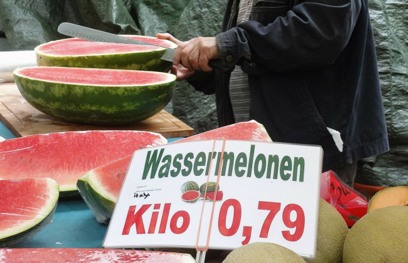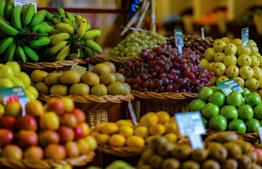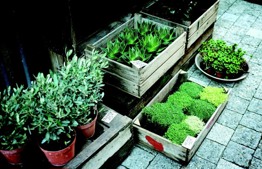Orlah, Chapter 7: Orlah fruit in the marketplace

Which fruits could be orlah in the marketplace? What happens when orlah fruit get mixed in with permitted fruit? On buying fruit in the marketplace and ratios of permitted to forbidden fruit required to nullify orlah.
- There are types of fruit trees that produce marketable fruit in their second and third years from the time they are planted, such as blueberries, apricots, nectarines, and seedless grapes (and more; the data changes often). For this reason, it is highly possible that such fruit will find its way to the marketplace when still of orlah[1]
- Optimally, one should buy produce only from stores with kashrut certification since these definitely do not sell orlah [2] If there are no stores with kashrut certification that can be found in one's close vicinity—or alternatively, the produce in such stores is more expensive—it is permissible to purchase fruit in the open market. This is only true of fruit where most is not orlah, due to the principle of kol deparish meruba parish.[3] It is proper to be stringent and refrain from buying types fruit when 10% or more of the fruits on the market are orlah.[4]
- If the fruit reaches the marketplace in its original packaging, and it is possible to identify its source, it is considered kavu'a and is forbidden to eat. This is even if generally most of this type of fruit is not forbidden due to orlah.[5]
- If one accidentally buys fruit at the marketplace from a booth without kashrut certification or is served fruit, it is permitted to eat it following the principle of kol deparish meruba parish.
- When it is known that the fruit is from a vineyard or orchard that has both orlah and non-orlah vines or trees: even if one does not know whether or not the fruit is orlah, it is forbidden to eat the fruit. This follows the principle kol kavu'a kamechtzah al mechtzah dami.[6] This is also applies to a vineyard or orchard that belong to a non-Jew (see Chapter 1, Section E).[7]
- If a person receives fruit from a friend that grew in the friend's yard and there is a doubt whether or not the fruit is orlah, one should inquire whether the trees are orlah. This is because the doubt about orlah relates to a specific place (kavu'a), thus the principle of kol kavu'a kamechtzah al mechtzah dami[8]
- Orlah fruit that is mixed with permitted fruit of the same type (such as orlah apples and permitted apples)—the prohibited fruit is nullified to the permitted fruit if the ratio between them is 1:200 (one prohibited fruit to 200 permitted fruits).[9] If the mixture is made of different types of fruits (like orlah grape juice mixed in with permitted applesauce)—the prohibition is nullified in a ratio of 1:60 (1 forbidden to 60 permitted fruits).[10]
[1] Data on the prevalence of orlah for various types of fruit is published biannually by Dr. Moshe Zaks in the pamphlet Halichot Sadeh (Hebrew) and posted on the Beit Midrash for Halachah in Agricultural Settlements – Emunat Ish website. This data is only an indication and does not have binding halachic implications. See Appendix A: Orlah fruit in the marketplace – a survey.
[2] Today (5779), most of the major supermarket chains bear reliable kashrut certification and do not sell orlah fruit. For a survey on the situation in the marketplace regarding the sale of orlah fruit, see Appendix A, ibid. As to the question of whether it is possible to rely on the word of the vendor that the fruit is not orlah, see" Rabbi Yehuda Amichay, "Trustworthiness of a vendor regarding orlah fruit," HaTorah VeHa'aretz V (5760), pp. 207–213: lechatchila, one should not rely on a vendor's word alone, but if already purchased and the level vendor's trustworthiness is unknown it is permitted to eat the fruit.
[3] For an explanation of the terms kavu'a and parish and the halachic principles kol deparish meruba parish and kol kavu'a kamechtzah al mechtzah dami, see Chapter 1, Section E and n. 31 and 33. According to most poskim, fruit in the marketplace are considered parish and not kavu'a. See Chazon Ish, YD §37:14, Minchat Yitzchak VII §96; Minchat Shlomo I §62:3, incipit achen; Yabiya Omer VI, §24; as opposed to the stance of Rabbi Yosef Shalom Elyashiv. See Rabbi Yaakov Navon, "The issue of orlah in contemporary times," Techumin VI (5745), pp. 383 and on; Rabbi Yoel Friedemann, "Purchasing fruit without kashrut certification in the marketplace,"Emunat Itecha, 84 (5770), pp. 32–39. See also Rabbi Mordechai Eliahu, "Orlah fruit in the marketplace—rov or kavu'a," HaTorah VeHa'aretz I (5749), pp. 11–22; he is stringent, based on the principle that one should not be lenient with any matter of doubt where investigation is possible vis-à-vis orlah.
[4] Derech Emunah, Hilchot Ma'aser Sheni chap. 9, Tziyun Hahalacha §48; Rabbi Yaakov Ariel, citedin Chevel Nachalato III, §31 pp.152–153. Yeshu'ot Moshe Rabbi Yehoshua Moshe Aharonson, Berurei Halachot Hateluyot Ba'aretz, Bene Berak 5747), p. 231, states that one need not be concerned even about a mi'ut hamatzuy (a substantial minority), since it is unrelated to nature but rather to human behavior. See also Shevet HaLevy V §156:4, incipit od bati and IV §81.
[5] Note by Rabbi Yaakov Ariel.
[6] Shulchan Aruch, YD §110:3; since the uncertainty arises in the kavu'a location, we employ yes – employ? the principle of kol kavu'a kamechtzah al mechtzah dami; when the prohibition is biblical, we are stringent.
[7] Shulchan Aruch, YD §294:9, here it is stated similarly that kol kavu'a kamechtzah al mechtzah dami.
[8] This case applies to a safek kavu'a, about which the poskim are divided. See Darchei Teshuva, YD §110:35, §100:84; when it is possible to find out whether or not the fruit is orlah, however, this certainly should be done.




